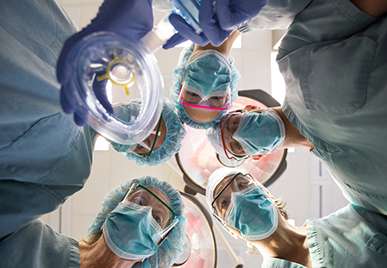Study finds many patients unaware of what the anesthesiologist actually does

When patients undergo surgery, there is a doctor in the operating room – the anesthesiologist – whose job is a mystery to many of them, according to new research by a Rutgers physician. That is unfortunate, the researcher says, because if patients had a better sense of what this doctor does, it would improve the chances that their surgery will be both successful and more comfortable.
"I feel that anesthesia is the topic than many patients know least about," says Ferdinand Iannaccone, an anesthesia resident at Rutgers New Jersey Medical School – who presented his findings at the annual meeting of the American Society of Anesthesiologists (ASA) – "and the best way to calm anxiety is to address the unknown."
More than 104 million surgeries involving anesthesia are performed every year, according to the ASA. Nearly half are inpatient procedures in hospitals; the rest are done in ambulatory care settings.
Iannaccone found that more than 90 percent of the patients he studied were aware that anesthesiologists "put patients to sleep," but fewer than half knew that the anesthesiologist also makes sure that patients are fit for surgery; monitors blood loss and provides transfusions, if needed; controls nausea and vomiting; and controls pain following surgery.
In each of those areas, Iannaccone says, "if they know more prior to their surgeries, they can be helpful to us as anesthesiologists by preparing themselves for what they're about to undergo."
That includes thinking ahead about a conversation they will have with the anesthesiologist during pre-operative screening – a chat that Iannaccone says many patients don't realize is part of the routine. An anesthesiologist who has reviewed the patient's lab work and medical history meets the patient and explains what is planned, including precautions based on the patient's profile – and then asks important questions looking for information that may not appear on a chart.
"A concern I would have is whether you had any interactions with anesthesia in the past," says Iannaccone. "Did you have nausea? Did you have vomiting after the surgery or severe pain? If the answer to any of those is yes, we might be able to either avoid or increase certain medications – or, if you had avoidable pain in the past, use other techniques like nerve blocks and regional anesthesia."
Iannaccone says an anesthesiologist wants the patient to feel as little pain as possible, and also for the patient not to remember much. "The patient won't want to remember the stress of the day – the built up anxiety prior to the surgery. We also don't want the patient to move during surgery, or to have any postoperative complications."
How that is accomplished can vary widely from patient to patient, and procedure to procedure. Iannaccone says his main concern during a surgery is the condition of the patient's heart and lungs, "because being under anesthesia those are the two organ systems that probably are the most stressed." One condition that can affect both is obesity, he says, because people who are overweight are more likely to have sleep apnea, which can disrupt the patient's breathing during surgery.
To guard against complications in patients at risk, Iannaccone says the anesthesiologist may decide to use monitors that instantly detect blood pressure changes, and have high capacity intravenous needles set up in case large amounts of blood need to be replaced quickly.
Offering choices to the patient
Beyond explaining and obtaining consent for all necessary procedures, Iannaccone also likes to give the patient a choice wherever he can, such as a local instead of general anesthesia if the surgery won't be especially invasive. "Whatever the patient would like," Iannaccone says, "we can at least approach it with a conversation."
Iannaccone is now applying his research results by testing a new high-tech way to make the conversation even richer. During pre-admission testing, his patients are getting digital tablets that offer quick tutorials designed to fill in gaps in their anesthesia knowledge. "It should take less than five minutes," Iannaccone says, "and while we don't expect that to leave them fully educated, we do expect it will make them more engaging in some of the questions they may have that we can answer for them."
First results on how well those tablets work may be available this spring.




















